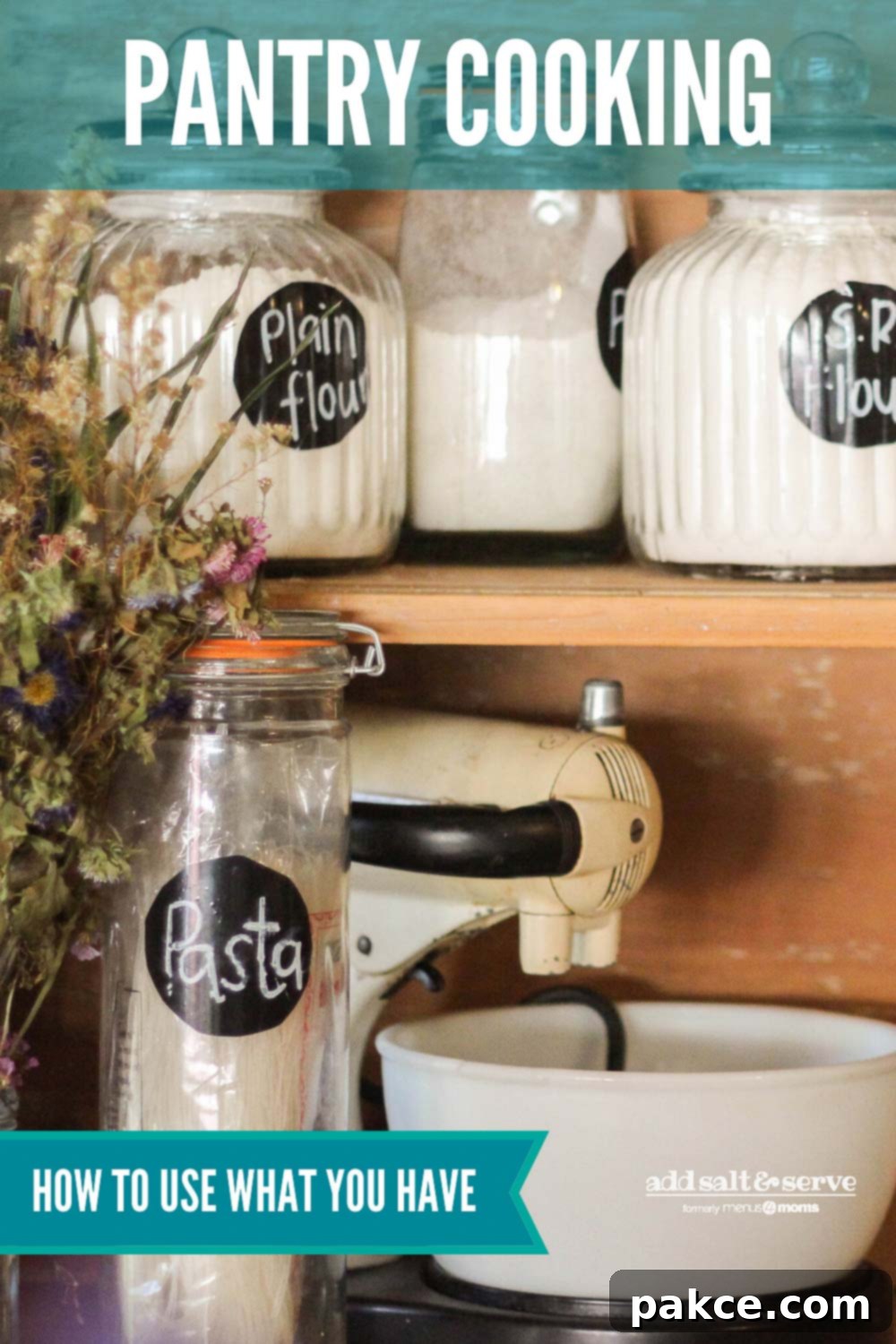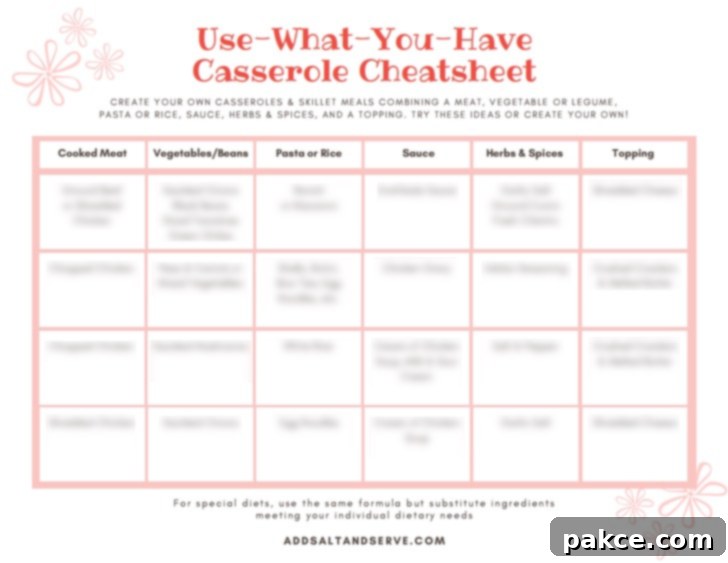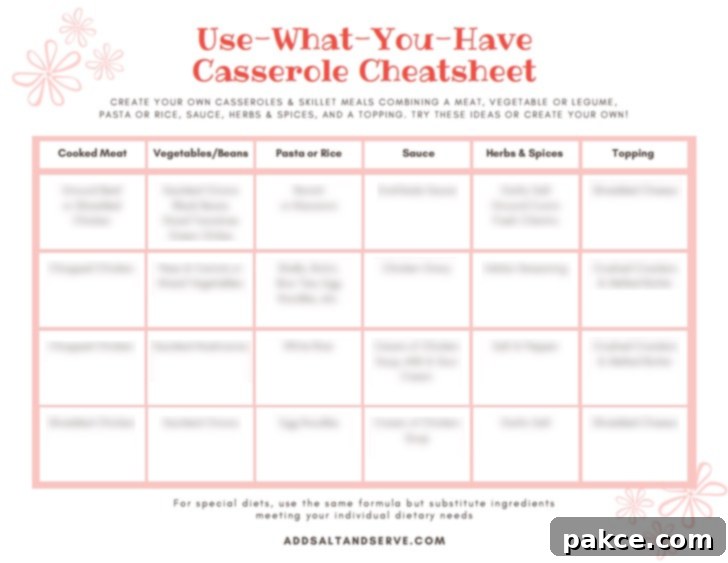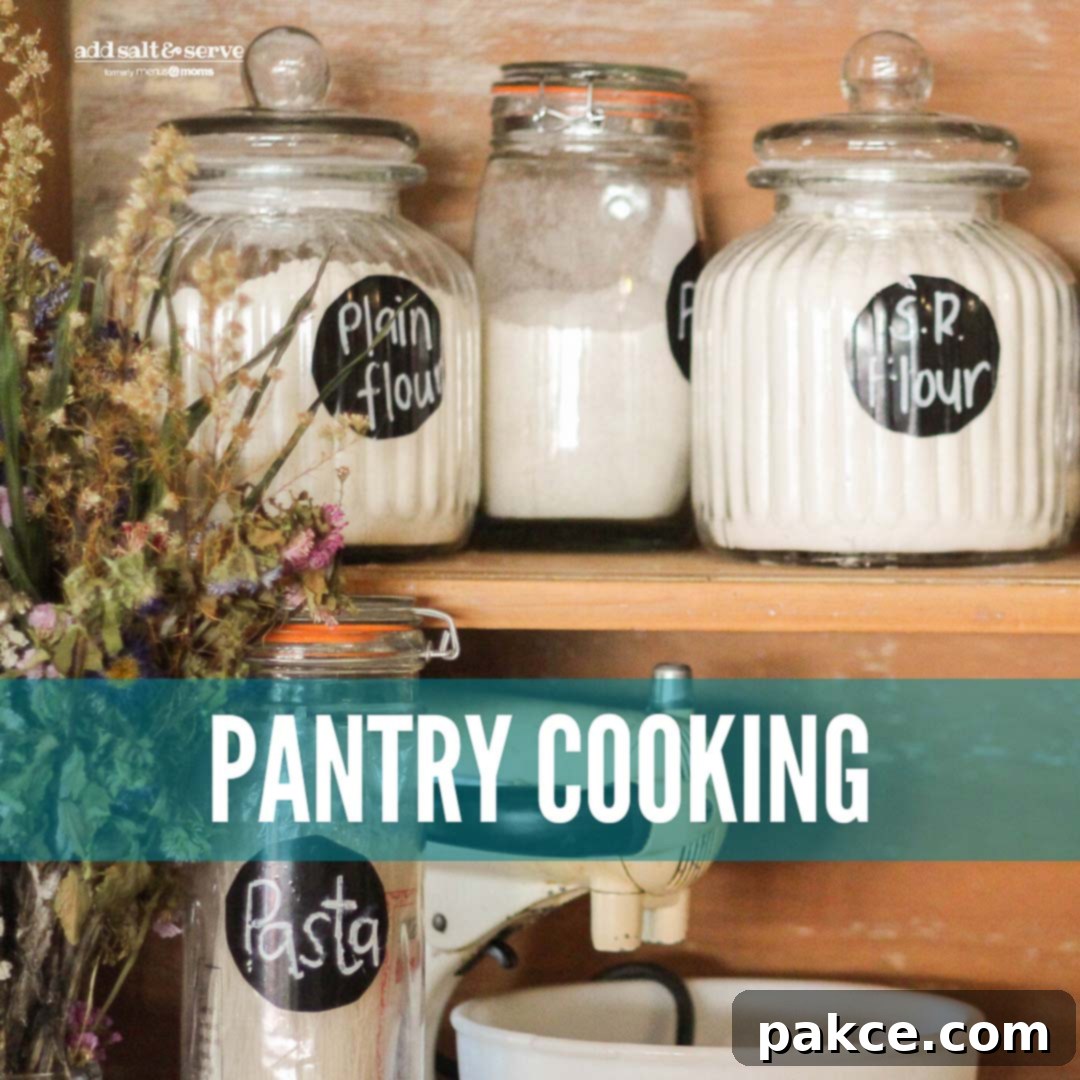Pantry Cooking: Master Easy & Delicious Meals with What You Already Have On Hand
Are you tired of searching for easy recipes only to discover you’re missing key ingredients? It’s a common dilemma that can turn cooking into a stressful chore. But what if you could create amazing meals without a special trip to the grocery store? Welcome to the world of pantry cooking! This guide will empower you with simple, versatile recipe ideas designed to utilize the ingredients you already have stocked in your pantry, fridge, and freezer. Say goodbye to the stress of ingredient hunting and hello to creative, budget-friendly meals that minimize food waste. Even if you’re not an experienced chef, these basic formulas and tips will make cooking with what you have both easy and enjoyable.

Download our exclusive cheatsheet printable for even more ideas on how to use what you have in your kitchen!

Building Your Pantry Staples Foundation
Before diving into specific recipes, let’s consider what makes a well-stocked pantry. Having a core set of non-perishable and versatile ingredients is the key to successful pantry cooking. This doesn’t mean you need to hoard, but rather curate items that can be combined in countless ways. Think about:
- Grains: Rice (white, brown), pasta (various shapes), oats, quinoa.
- Canned Goods: Beans (black, cannellini, kidney, chickpeas), tomatoes (diced, crushed, paste), broths (chicken, vegetable, beef), tuna, salmon, olives, corn, green beans.
- Long-lasting Produce: Onions, garlic, potatoes, sweet potatoes, hard squash.
- Fats & Oils: Olive oil, vegetable oil, butter.
- Dairy & Eggs: Milk, cheese (shredded or blocks), eggs.
- Frozen Goods: Mixed vegetables, spinach, peas, corn, fruits, cooked meats/proteins (chicken, ground beef).
- Sauces & Condiments: Soy sauce, vinegar (balsamic, apple cider, white), mustard, hot sauce, salsa, pasta sauce, peanut butter.
- Baking Essentials: Flour, sugar, salt, pepper, baking powder, baking soda.
- Herbs & Spices: A comprehensive selection, as discussed below.
With these basic pantry staples, you’ll be amazed at the variety of meals you can whip up without a second thought.
Eggs: Versatile Meal Starters
Eggs aren’t just for breakfast! They are an incredibly versatile and protein-rich ingredient that can anchor a meal at any time of day. When you’re looking for an easy, satisfying dish using what you have, eggs are often the answer.
-
Strata: Layered Perfection
A strata is essentially a savory bread pudding, perfect for using up stale bread and leftover cheese. It’s an ideal brunch or light dinner option.
How to make it: Layer bread (any kind, even stale) and sliced or shredded cheese in a baking pan. Whisk together 4 eggs, about 2-⅔ cups of milk, and season with a little salt, pepper, and a pinch of dry mustard for depth. Pour this egg mixture over the bread and cheese, ensuring everything is well saturated. Bake at 350ºF (175ºC) for approximately 45 minutes. Baking time may vary depending on the size and depth of your pan, so check for doneness by ensuring the egg is fully set in the center.
Pantry Tip: Add sautéed onions, frozen spinach (thawed and squeezed dry), or any cooked leftover meat (ham, sausage) to elevate your strata.
-
Crustless Quiche: Simple and Savory
A crustless quiche offers all the deliciousness of a traditional quiche without the fuss of preparing a crust. It’s a fantastic way to incorporate vegetables and dairy.
How to make it: Beat 8 eggs with a cup of milk, a cup of your favorite shredded cheese (cheddar, mozzarella, Swiss work well), and season with salt and pepper. Stir in a 10 oz package of frozen vegetables (like broccoli, spinach, or mixed veggies) that have been cooked, drained, and chopped. Pour the mixture into a pie plate or baking dish and bake at 350°F (175ºC) for about 40-50 minutes, or until a knife inserted into the center comes out clean. The top should be golden brown.
Pantry Tip: Don’t have fresh milk? Reconstituted powdered milk or even a plant-based milk substitute can work in a pinch. Vary the cheese and vegetable combinations based on what’s available.
-
Other Egg-Centric Ideas
Beyond strata and quiche, eggs can transform into quick meals like frittatas (similar to crustless quiche but often started on the stovetop and finished in the oven), omelets packed with leftover veggies and cheese, or even simple scrambled eggs served with canned beans and tortillas for a makeshift breakfast burrito.
Casseroles: The Ultimate Comfort Food Solution
Casseroles are the champions of “use what you have” cooking. They are incredibly forgiving, allowing for endless combinations of ingredients. The basic formula involves a protein, a starch, vegetables, a binder (sauce), and a topping, all baked together into a hearty, satisfying meal. This method not only simplifies cooking but also helps you clear out those lingering leftovers.
It’s easy to make a variety of casseroles by using different combinations of the following core components:
- Protein: Cooked meat (chicken, ground beef, sausage, ham, tuna), canned beans or lentils for vegetarian options.
- Starch: Cooked pasta (any shape), rice, potatoes (diced, sliced, shredded), stale bread.
- Vegetables: Fresh, frozen, or canned – anything from peas and carrots to spinach, mushrooms, or bell peppers.
- Sauce/Binder: Pasta sauce, cream of mushroom/chicken soup (canned), homemade gravy, béchamel sauce, salsa, enchilada sauce.
- Herbs & Spices: To match your desired flavor profile (Italian seasoning, chili powder, curry powder, etc.).
- Topping: Shredded cheese, bread crumbs (mixed with a little melted butter for crispiness), crushed crackers, French fried onions, or even crushed potato chips.
The beauty of casseroles lies in their adaptability. Vary the type and shape of pasta, the vegetables you add, and the kind of sauce and topping to keep things exciting. Mix all chosen ingredients in a baking dish and bake at 350ºF (175ºC) until heated through, bubbly, and the topping is golden brown.
Here are some classic examples:
-
Italian Pasta Bake
How to make it: Combine cooked ground beef (or Italian sausage), cooked pasta (penne, rotini, or spaghetti works well), sautéed onions, and your favorite marinara or pasta sauce. Pour the mixture into a baking pan. For a classic finish, sprinkle with bread crumbs and dot with small pats of butter for extra crispiness and flavor. Bake at 350ºF (175ºC) for about 25 minutes, or until the casserole is hot and bubbly and the topping is lightly browned.
Pantry Tip: Enhance the flavor with dried Italian herbs, a sprinkle of garlic powder, and a layer of mozzarella or Parmesan cheese under the breadcrumbs.
-
Mexican Pasta Bake
How to make it: Mix cubed cooked chicken (or ground beef/turkey) with cooked pasta (elbow macaroni or small shells are good choices), canned green chilies, diced tomatoes (canned), sautéed onions, and a can of red enchilada sauce. Transfer this flavorful mixture into a baking pan. Top generously with shredded cheddar or Monterey Jack cheese. Bake at 350ºF (175ºC) for 30 minutes, until the cheese is melted and bubbly.
Pantry Tip: Add a can of drained black beans or corn for extra texture and nutrition. A dash of cumin and chili powder will boost the Mexican flavors.
-
Creative Casserole Combinations
Don’t be afraid to experiment! A tuna noodle casserole is a timeless pantry meal, combining canned tuna, pasta, canned cream soup, and frozen peas. Or consider a shepherd’s pie variation with leftover mashed potatoes as a topping, covering ground meat and mixed vegetables in gravy. The possibilities are truly endless when you start seeing your pantry as a palette of ingredients.
Stovetop Meals: Quick and Easy One-Pan Wonders
When time is of the essence or you simply don’t want to heat up the oven, stovetop meals are your best friend. They follow a similar “mix and match” principle to casseroles but are cooked entirely on the burner, often resulting in quicker cooking times and fewer dishes. The same core ingredients—cooked meat, vegetables, pasta or grains, and a sauce—can be combined to create a multitude of different dishes.
Simply sauté your aromatics (onions, garlic), add your protein, vegetables, and cooked starch, then introduce your chosen sauce, herbs, and spices. Simmer until everything is heated through and flavors have melded.
A couple of examples to get you started:
-
Mediterranean Stovetop Meal
How to make it: In a large skillet, combine cooked chicken (shredded or diced), cooked pasta (orzo or small shells work well), and a medley of Mediterranean vegetables such as black olives, sun-dried or diced canned tomatoes, and roasted red peppers (from a jar). Add a splash of balsamic vinegar and a drizzle of olive oil, then heat through until warmed. Serve topped with crumbled feta cheese, shredded mozzarella, or grated Parmesan.
Pantry Tip: Canned chickpeas or white beans can be a great addition for extra protein and fiber. Fresh or dried oregano and basil will enhance the Mediterranean flavors.
-
Mexican Ravioli
How to make it: For a delightful fusion meal, combine cooked beef ravioli (frozen or fresh) with a can of red enchilada sauce, a cup of your favorite salsa, and a can of sliced black olives in a skillet. Stir well and heat until the ravioli is thoroughly warmed and the sauce is bubbling. Finish by stirring in or topping with shredded cheese until melted and gooey.
Pantry Tip: Ground beef or chicken can be browned and added to this dish for extra heartiness. A sprinkle of fresh cilantro, if you have it, adds a vibrant touch.
-
Quick Stovetop Skillets
Consider simple stir-fries with rice or noodles and any combination of vegetables (fresh or frozen) and protein. Or a creamy pasta dish using canned cream soup, milk, and cheese, mixed with pre-cooked chicken and frozen peas. The speed and adaptability of stovetop cooking make it a weeknight savior.
Soups: The Ultimate Leftover Revitalizer
Soup truly is one of the easiest and most forgiving recipes imaginable. It’s the absolute best way to utilize leftovers, miscellaneous frozen vegetables, and pantry staples. Soups are incredibly adaptable—they welcome almost any ingredient combination and can be easily adjusted as they cook until the flavor profile is exactly to your liking. They are also fantastic for meal prepping and often taste even better the next day!
A smart strategy to make the most of leftovers and minimize food waste is to designate a container in your freezer for any small portions of leftover vegetables throughout the week. At the end of the week, combine these “freezer clean-out” vegetables with any cooked meat you have in the refrigerator (or a can of beans for a vegetarian option) to create a fantastic, hearty pot of soup.
End of the Week Soup Formula
How to make it: Start by sautéing onions or garlic (fresh or powdered) in a large pot with a little oil. Add your chosen broth (chicken, vegetable, or beef broth that complements your meat), any cooked meat, your collection of freezer-found vegetables, and your preferred herbs and spices. Bring the mixture to a boil, then reduce the heat and simmer until all ingredients are tender and flavors have melded. If you’re adding pasta, cook it separately and serve it into individual bowls before ladling the soup over it. This prevents the pasta from absorbing all the broth and becoming mushy if you have leftovers.
Pantry Tip: Don’t forget canned beans, lentils, or even rice as a base for hearty soups. A can of diced tomatoes or a spoonful of tomato paste can add depth and richness. A splash of vinegar or lemon juice at the end can brighten the flavors.
Broth-Based vs. Creamy Soups
Soups can range from light, clear broths to rich, creamy concoctions. For broth-based soups, focus on fresh herbs, a good quality broth, and chunky vegetables. For creamy soups, a roux (butter and flour) or a can of cream of mushroom/chicken soup can be used as a base, thickened with milk or cream (or a dairy-free alternative). Pureeing a portion of the soup can also create a naturally thicker, creamier texture using just vegetables.
Salads: Fresh and Flavorful Without the Cook Time
When the weather is warm, or you simply crave something lighter, chilled pasta, grain, or legume salads are an excellent way to use up whatever you have on hand. The principles for combining ingredients are much like those for casseroles, but instead of a hot sauce, you’ll use a complementary salad dressing. These salads are perfect for meal prep and make great lunches.
Think in terms of cuisine categories and include ingredients that naturally go well together, just as you would with a casserole or stovetop meal. The key is balance: protein, vegetables, a grain/pasta base, and a flavorful dressing.
Dressing Choices to Match Your Cuisine
The dressing is often the unifying element that brings all the flavors together in a salad.
- Italian-inspired Salads: Use a classic Italian vinaigrette or a tangy balsamic dressing. Think cooked pasta, cherry tomatoes, black olives, mozzarella, and maybe some leftover pepperoni or chicken.
- Mexican-inspired Salads: A zesty French or creamy ranch dressing can work wonders. Combine cooked rice or quinoa, black beans, corn, diced bell peppers, shredded chicken or ground beef, and a sprinkle of cilantro.
- Mediterranean-inspired Salads: Opt for a bright Greek vinaigrette, a cooling tzatziki dressing, or even a robust blue cheese dressing. Ingredients might include cooked lentils or orzo, cucumbers, tomatoes, feta cheese, chickpeas, and roasted red peppers.
- Asian-inspired Salads: A sesame-ginger dressing or a peanut dressing will tie everything together. Use cooked noodles or rice, shredded carrots, edamame, cooked chicken or tofu, and a sprinkle of sesame seeds.
Grain and Legume Salads
Beyond pasta, consider using cooked quinoa, couscous, farro, or even leftover rice as the base for your cold salads. Canned chickpeas, black beans, or lentils are fantastic for adding protein and substance. These bases absorb dressings beautifully and offer a delightful texture that makes salads feel more substantial.
Mastering Flavor: Help with Herbs & Spices
Herbs and spices are the unsung heroes of pantry cooking. They can transform a simple combination of ingredients into a memorable meal. When deciding which combinations of ingredients, herbs, and spices to use, a great starting point is to think about the flavor profiles in the recipes your family already loves. If they enjoy Mexican food, lean into cumin, chili powder, and oregano. If Italian is a favorite, reach for basil, oregano, and garlic powder.
Building Your Basic Spice Rack
A well-stocked spice rack doesn’t need to be extensive, but having key players is crucial:
- Essentials: Salt (kosher or sea salt), Black Pepper (freshly ground is best), Garlic Powder, Onion Powder.
- Herbs: Dried Oregano, Basil, Thyme, Rosemary, Bay Leaves, Parsley Flakes.
- Spices: Cumin, Chili Powder, Paprika (sweet or smoked), Turmeric, Coriander, Red Pepper Flakes.
- Baking Spices: Cinnamon, Nutmeg, Ginger, Cloves.
Don’t be afraid to taste and adjust! Start with a small amount and add more as needed. Remember that dried herbs are more potent than fresh ones, so use sparingly at first.
The Flavor Bible: Your Culinary Companion
For those times you’re feeling adventurous or simply stuck, you may wish to invest in the digital version of The Flavor Bible (affiliate link). This incredible resource is a game-changer if you have an ingredient you want to use and aren’t sure what to pair with it, particularly when it comes to selecting complementary herbs and spices. It’s an invaluable tool for building confidence and creativity in your kitchen.
Don’t forget to download our printable cheatsheet with even more ideas for how to use what you have!

Pantry cooking isn’t just about making do; it’s about culinary creativity, resourcefulness, and efficiency. By embracing these simple formulas and thinking flexibly about ingredients, you can transform everyday pantry items into extraordinary meals. Have you discovered any ingenious recipes using this method of cooking? We’d love to hear about your pantry cooking triumphs and unique combinations in the comments section below!
More Versatile Recipes To Use What’s On Hand
- Quick & Easy Mexican Style Soup
- One Pot Tomato Spinach Pasta
- Cheesy Tuna Casserole
- Chicken Fried Rice
See more versatile recipes >
